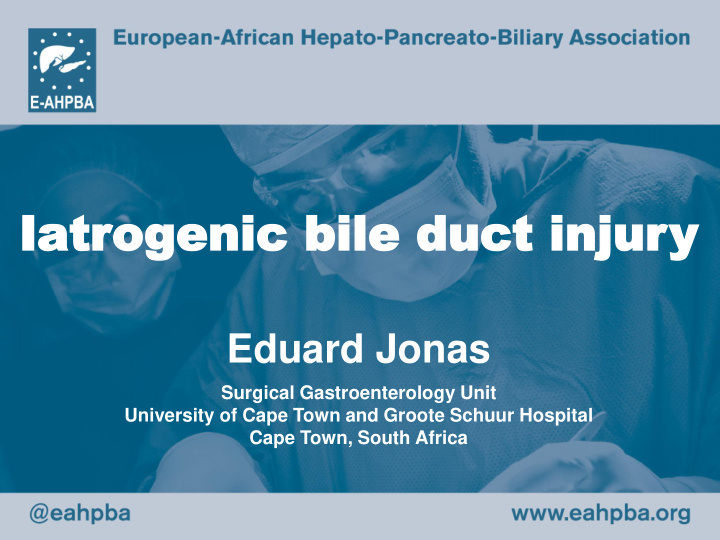



Ia Iatr trogenic ogenic bile duct bile duct injur injury Eduard Jonas Surgical Gastroenterology Unit University of Cape Town and Groote Schuur Hospital Cape Town, South Africa
Conflict of Interest I declare I have no conflict of interest
Social Media You are welcome to share details of this presentation responsibly and with due credit on social media.
Bile duct injury (BDI) “ ” • Significant associated BDI incidence morbidity and mortality • Significantly increasing “ Learning curve ” 2-4 OC era 1 Beyond the curve 5,6 0.3% – 0.82% 0.22% – 0.4% 0.20% cost of treatment Time • Common causes of litigation in general surgery 1 Roslyn et al. Ann Surg. 1993;218(2):129-37 • It severely decreases QOL 2 Nuzzo et al. Arch Surg. 2005;140(10):986-92 3 Karvonen et al. Surg Endosc. 2011;25(9):2906-10 4 Tornqvist et al. BMJ. 2012;345:e6457 for the patient 5 Barret et al. Surg Endosc. 2018;32:1683-88 6 Fong et al. JACS. 2018;226(4):568-76
Classification ATOM Strasberg
Management Timing of repair Time of detection – Immediate – Intraoperative – Early – Post-operative – Delayed – Late – Late Spectrum of deranged physiology
Patient case 1 • 45 year old male presented to peripheral hospital (100 km away) with sudden onset abdominal pain • early cholecystitis - laparoscopic cholecystectomy • telephone call from theatre – divided cystic duct – divided cystic artery – dissecting gallbladder - encountered and severed another duct • What now?
Management options • Repair by the injuring surgeon • Experienced surgeon travel to do repair • Immediate referral to a specialist center
Injuring surgeon repair Successful long-term outcome Primary surgeon repair - 27% Referred patients - 79% Stewart L, et al. Arch Surg. 1995 Oct;130:1123-8 Carroll BJ, et al. Surg Endosc. 1998;12:310-3
(Travel) immediate repair • Not playing a home match • Suboptimal conditions • Extent of the injury may not be evident • Limited investigation possibilities • Creating more havoc looking for the missing parts in the puzzle
Immediate repair
Referral to specialist center Advice to injuring surgeon • Stop operating! • Control/exteriorize the leak • Closed (suction) drain
Work-up • Physiology of the patient • Extent of the bile duct injury • Associated vascular injury • Free fluid / fluid collections • Status of the liver
Imaging • Cross-sectional imaging – CE-MDCT – CE-MRI / MRCP • Interventional imaging – ERCP – PTC
CE-MDCT • Dilated bile ducts (cholangiogram) • Free fluid • Vascular injury • Perfusion defects
99mTc-IDA
CE-MRI/MRCP T2-weighted T1-weighted
PTC? • Diagnostic information • Obstructed duct decompression • Act as infra-hepatic drain • Facilitate intra-operative identification of bile ducts • Decompression of peri- anastomotic duct • Allows post-reconstruction imaging • Definitive management?
Patient case 1 cont. • Clinically well • Soft abdomen • WCC slightly raised • LFTs minimally deranged
Patient case 1 cont.
Surgery
Technique • Minimal dissection especially behind ducts • Tension free mucosa to mucosa anastomosis to well perfused duct • Hepaticojejunostomy preferred • Proximal anastomosis • Hepp-Couinaud approach
Technique Atlas of Upper Gastrointestinaland Hepato-Pancreato-Biliary Surgery. Springer-Verlag Berlin Heidelberg 2007
Technique Atlas of Upper Gastrointestinaland Hepato-Pancreato-Biliary Surgery. Springer-Verlag Berlin Heidelberg 2007
Intra-operative PTC
Postoperative course
Coexistence of anomalies With arterial anomalies (non-Michel 1) approximately 70% of patients will have some form biliary anomaly Absent RHD 35% RPSD drains into LHD 20% RPSD low insertion 20%
Patient case 2 • 33-year-old morbidly obese female BMI 53 • elective laparoscopic cholecystectomy • BDI diagnosed on post-operative day 22 • laparotomy with washout and drainage • arrived on day 28 post-injury • uncontrolled sepsis
Patient case 2 cont.
Patient case 2 cont. Lindemann J, et al. Int J Surg Case Rep. 2019;60:340-344
Patient case 2 cont.
Patient case 2 cont.
Patient case 2 cont.
Timing of repair
Summary • Multidisciplinary management • Individualize patient treatment • Manage the patient • Optimal pe-operative information • Correct physiology and nutritional status • Early repair preferable, delay when necessary
Recommend
More recommend